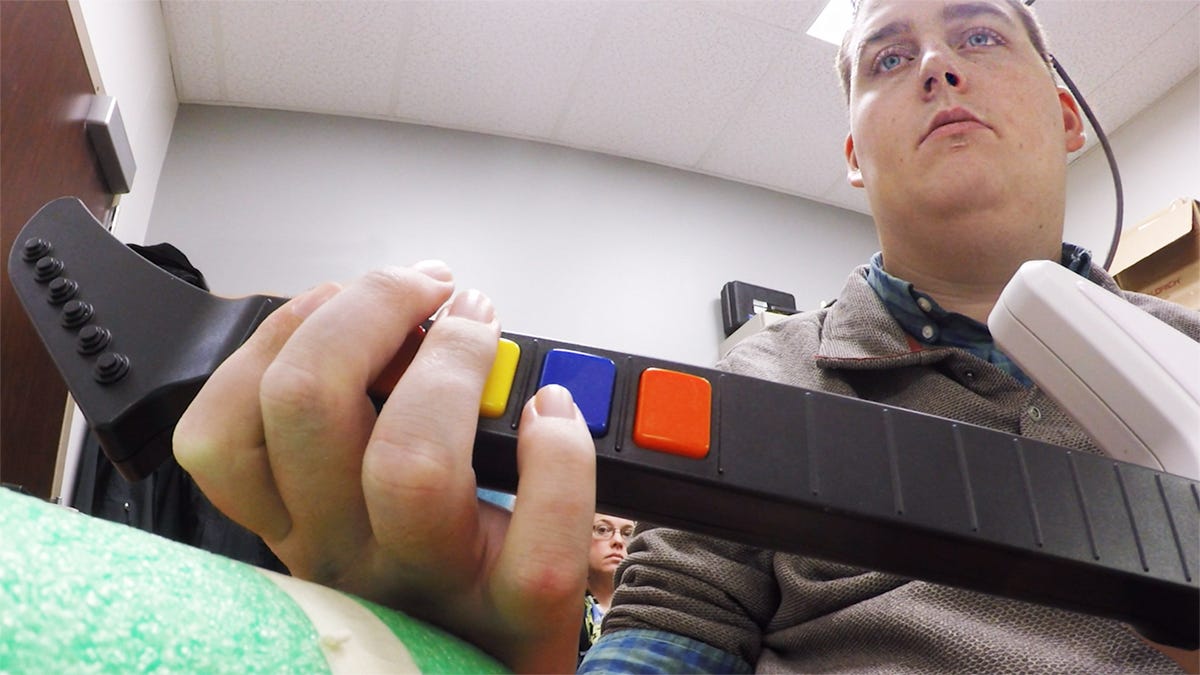Brain implant lets quadriplegic man use his own hand
A quadriplegic man is now able to play Guitar Hero, swipe a credit card and pour liquid into a glass with his own hand.
He was just 19 years old when a diving accident injured his spine and paralysed Ian Burkhart's entire body from the neck down. He was left with some small use of his arms, and no use of his legs.
Now 24, Burkhart, who is from Dublin, Ohio, is able to do things he hadn't believed possible, thanks to a pea-sized implant in his brain. It's called NeuroLife, and Burkhart has been working with applied science development nonprofit Battelle and The Ohio State University Wexner Medical Center to prove the concept of the technology. The research has been published in the journal Nature.
"Participating in this research has changed me in the sense that I have a lot more hope for the future now," Burkhart said. "I always did have a certain level of hope, but now I know, first-hand, that there are going to be improvements in science and technology that will make my life better."
Two years ago, neurosurgeon Ali Rezai implanted the microelectrode array in the motor cortex of Burkhart's brain. This chip reads the electrical activity in the motor cortex and sends it to a computer in real-time.
The computer then recodes the signal and sends it to a high-definition muscle stimulation electrode sleeve worn by Burkhart. This sleeve transmits the signals into Burkhart's muscles, allowing him to move his hand and fingers. This process takes a tenth of a second. Burkhart first demonstrated it in June 2014 by opening and closing his hand.
It has taken two years of hard work for the team to get to this point, but it's been worth it: Burkhart can now use his right hand. He can retrieve a card from his wallet and swipe it, manipulate a game controller, and even pour water.
Part of the challenge has been tailoring the system to Burkhart's brain. Every move you make uses different brain signals. Interpreting the signal that Burkhart's brain uses to turn his hand, or curl his fingers, or just curl one finger, takes time. The system needs to be trained to the user's brain, and the user needs to be trained to use the system.
"During the last decade, we've learned how to decipher brain signals in patients who are completely paralysed and now, for the first time, those thoughts are being turned into movement," said study co-author Chad Bouton, who spent over a decade designing the NeuroLife system for Battelle.
Burkhart pours dice from one cup to another.
"Our findings show that signals recorded from within the brain can be re-routed around an injury to the spinal cord, allowing restoration of functional movement and even movement of individual fingers."
In addition, Burkhart's muscles had atrophied from disuse, and he needed to work on building them up again.
"It's amazing to see what he's accomplished," said Batelle's project engineering lead, Nick Annetta. "Ian can grasp a bottle, pour the contents of the bottle into a jar and put the bottle back down. Then he takes a stir bar, grips that and then stirs the contents of the jar that he just poured and puts it back down. He's controlling it every step of the way."
Burkhart was just the first of five potential clinical trial participants. The second clinical trial is due to start later this year, with the end goal of evolving NeuroLife into a wireless system patients can use at home.
"In the 30 years I've been in this field, this is the first time we've been able to offer realistic hope to people who have very challenging lives," said Jerry Mysiw, chair of the Department of Physical Medicine and Rehabilitation at OSU, who helped design the clinical trial. "What we're looking to do is help these people regain more control over their bodies."


